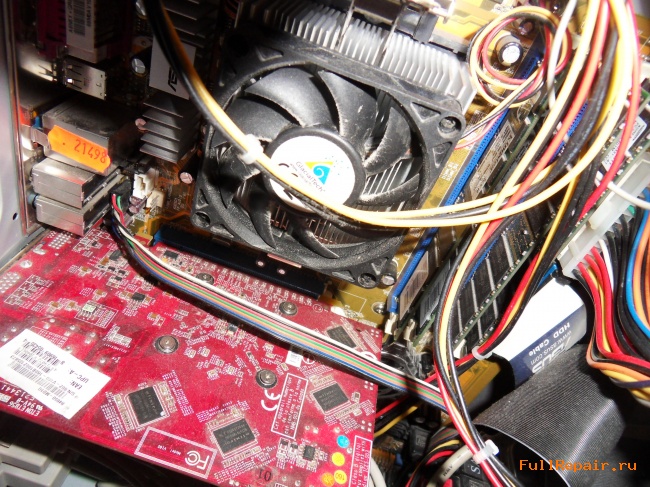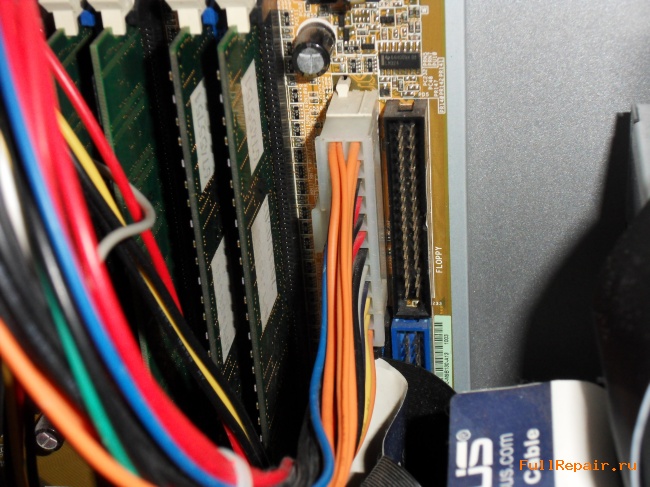Before you begin troubleshooting your computer when not in use, check for voltage at the mains, repair extension, UPS, if any, outlets and supply cords. Be sure to check the circuit breaker, which is usually located at the top rear of the cabinet, as during cleaning or wiping the dust you could disable it by accident.

After a visual inspection of the surface of the computer and check all the contacts connecting wires can go to the internal inspection system unit. To do this, remove the left cover. Look on the back of the chassis the two screws. Removing them, you can easily remove the side cover, gently sliding it back.
If inside the system has accumulated a large amount of dust, it must be cleaned from it. This can be done using an ordinary vacuum cleaner and a small soft brush. This procedure is recommended to perform at least once a year even with good computer, as a large amount of dust can also cause a malfunction.
Dust the need not only to the motherboard and fans, but also the internal parts of the power supply. After loosening the four screws located at the top rear of the chassis, power supply unit can be removed. To access the inside of the power supply, remove the top cover, which is usually attached with four screws. After the cleaning procedure you can go directly to the diagnosis, the course of which usually depends on the external symptoms of a faulty computer.

If you press the power button on the system unit does not respond, then the cause of the problem, most likely, lies in the power supply or motherboard. Check the fuse in the power supply, which is usually located inside the unit and be sure to inspect all the capacitors that are on the motherboard and the power supply. If at least one of them is swollen, then it must be replaced with a new one of the same capacity and voltage (the voltage can be more original.)

If a capacitor is OK, but other fault on the motherboard and the power supply is not visually detected, you can try to reset the BIOS using a special jumper located on the motherboard. If you do not have one, or you could not find it, you can for a few seconds to get a lithium battery when the power supply lead. This battery is flat and round, is located on the motherboard. The effect is the same.
If the above is not done by the work, you must disconnect it from the power supply and motherboard all the internals of the system unit (CD and DVD-drives, hard drives, PCI-card, etc.), leaving only the video card. The computer is connected to the mains and you press Power. If the computer is turned on, it must be switched off and again in order to connect all disconnected devices, checking each one ending. If, after connecting the nth unit refused to turn on the computer, then the cause of the fault will be in this device. Defective unit must be attributed to repair or replace a new one.
If even after all the devices you can successfully turn on, it means that the problem was hidden in a poor contact. Otherwise, you must replace the power supply or motherboard.
It may happen that after pressing the power button on the sound of the fans of the system unit and the monitor there is no signal. In this case, the cause of the fault to be found in memory, the motherboard or video card. Try using an ordinary eraser to clean the contacts on the memory modules. If that does not work, then try to replace these modules on the same or try to start the computer leaving one of the modules. In the same way the video card is checked.
If instead of "Check the cable" on the screen will show "Not Optimum Mode. We recommend ... ", it is likely to be because the screen is set too high refresh rate. To reduce the frequency of updating the system unit is enough to connect to a different, more modern monitor. If that does not work, the monitor needs to be replaced.
If the computer is turned on and loaded correctly, but the screen of the monitor periodically have all sorts of noise, accompanied by a partial lock-ups, you need to check the contacts connect the motherboard to the power supply. Due to the large accumulation of dust, some contacts may partially withdraw. The fault is cleared by clearing contacts. It is also necessary to test for errors memory.
If you boot your computer hard drive is not detected (hard disk drive), or working too frequently get a blue screen, check the following faults:
- bad connection loops.
- Poor contact between the power block and the hard drive.
- Oxidized contact memory.
Sometimes after copying to the hard drive refuses to install the operating system, constantly errors out of the impossibility of reading a file. This most often happens when a faulty memory or memory controller. Broken (bad, Bad block) sector of the hard disk can also be a reason for not installing the operating system. If as a result of heavy overload (eg, during the game) computer may restart, check the CPU and graphics card to the possibility of overheating. Insufficient capacity of the power supply can also be a cause of sudden reboots.
To remove the processor from overheating in many cases it is enough to clean the fan and the CPU heatsink from dust. If the processor has been subject to acceleration, it must be returned to the nominal frequency, or to put a more powerful cooling device.
Internal fault in the power supply or the lack of power, viruses, problems with the motherboard overheating of the elements of the motherboard or video card can cause spontaneous shutdowns or reboots.
Unstable working memory can lead to frequent errors when installing the software.
 Full-Repair.com
Full-Repair.com